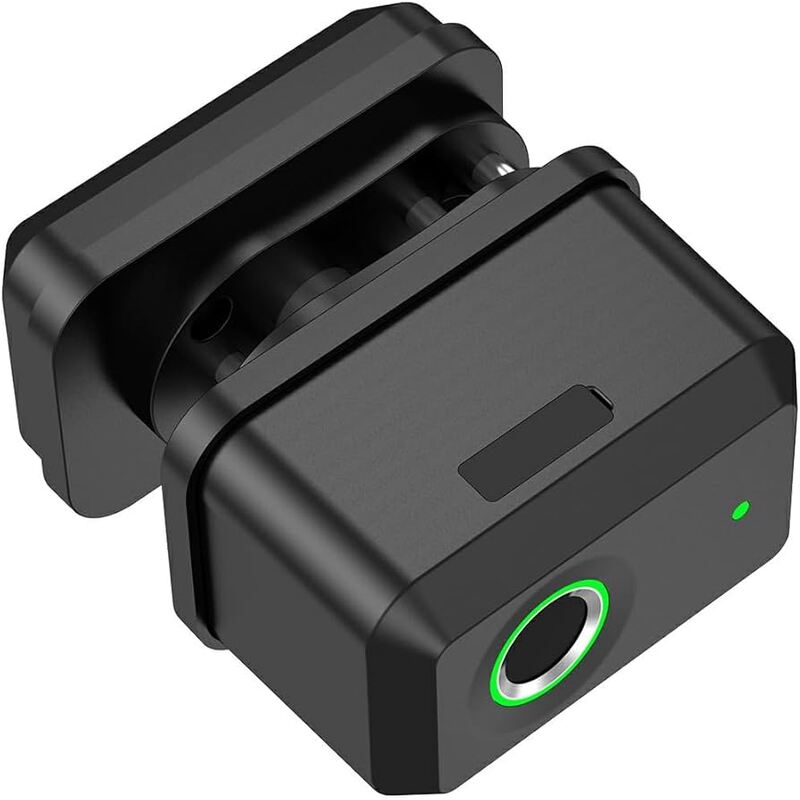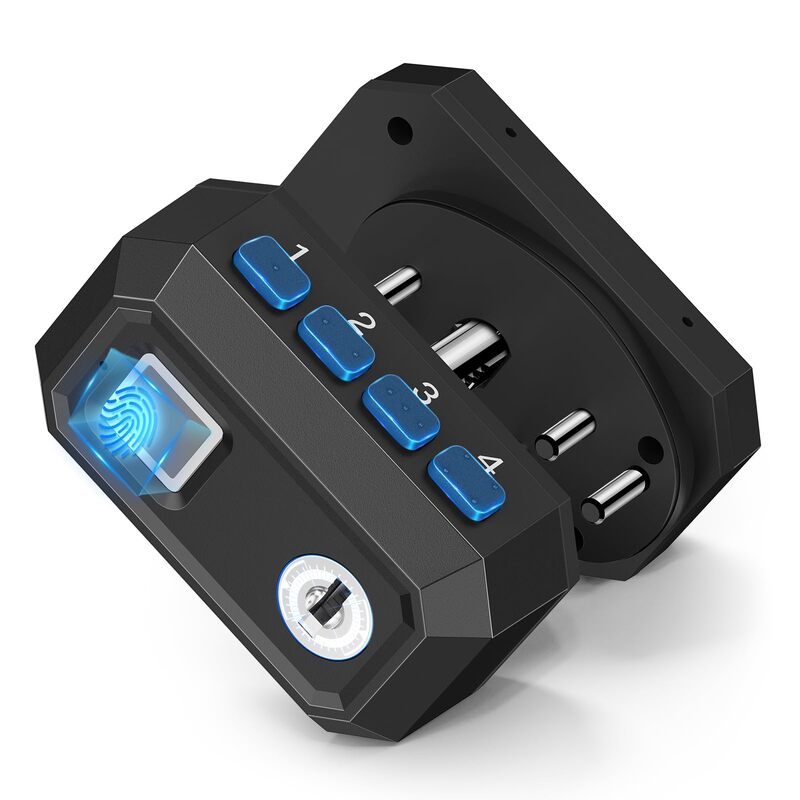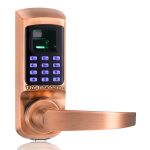Fingerprint trigger locks have transformed personal security and firearm safety. Gone are the days of fumbling for keys or memorizing combinations. Now, people can safeguard their firearms with the touch of a finger. This modern technology combines convenience with enhanced security. As a result, many firearm owners are adopting this innovative approach. However, understanding how these locks work and their benefits is crucial. In this article, we will explore the ins and outs of fingerprint trigger locks. We aim to provide an in-depth understanding of this technology.
What is a Fingerprint Trigger Lock?
Fingerprint trigger locks are specialized safety devices. They use biometric technology to secure firearms. Essentially, they replace traditional locking mechanisms with fingerprint recognition. Users must register their fingerprints into the system for access. Once registered, the lock recognizes legitimate users quickly. This feature significantly increases the odds of quick access in emergencies. However, unauthorized users cannot operate the lock.
Advantages of Biometric Technology
Biometric technology has multiple advantages over traditional locking systems. Primarily, it offers enhanced security. Unlike keys or codes, fingerprints are unique to each individual. This uniqueness means only registered users can gain access. In addition to heightened security, biometric systems provide convenience. Users can unlock their firearms swiftly with just one touch.
User Registration Process
Registering fingerprints is generally straightforward. First, users must clean the scanner for accurate readings. Next, the system requires users to press their fingers on the sensor multiple times. The scanner records different angles and pressure. After that, the system stores the data for future access. Some advanced models can store multiple fingerprints too. This feature allows several trusted individuals to access the firearm. It is essential to follow the manufacturer’s instructions for a successful registration process.

Key Features of Fingerprint Trigger Locks
Several key features distinguish fingerprint trigger locks from traditional locks. These features contribute to both security and usability. Understanding these characteristics is essential for potential buyers. By knowing what to look for, buyers can choose the right model that suits their needs.
Quick Access and Response Time
One of the most critical features is quick access. Most fingerprint trigger locks unlock in less than a second. This speed is crucial in emergency situations. Imagine having to enter a combination or search for a key in a critical moment. On the other hand, biometric locks minimize these concerns. With practice, users can achieve a smooth unlocking motion, ensuring readiness.
Multiple User Capabilities
Many fingerprint trigger locks support multiple user registrations. This feature is especially beneficial for families. Parents can register their fingerprints along with trusted relatives. Hence, everyone can access the firearm securely when needed. However, users should be cautious about who they grant access to. Limiting access to trustworthy individuals is vital for firearm safety. This careful consideration prevents unauthorized access and adds an extra layer of protection.
The Importance of Fingerprint Trigger Locks in Firearm Safety
Fingerprint trigger locks play an essential role in firearm safety. They not only protect firearms from unauthorized users but also help prevent accidents. Enhancing firearm safety is a responsibility shared by all gun owners. With incidents of gun violence increasing, responsible storage becomes more critical.
Reducing Child Access
One of the primary concerns with firearms is child safety. Children are naturally curious and may not understand the dangers. Fingerprint trigger locks provide a solution to this dilemma. Since only registered users can access the firearm, unauthorized use by children is significantly reduced. Moreover, firearm accidents involving children can be decreased. Families can enjoy peace of mind knowing that their firearms are safely stored away from curious hands.
Preventing Theft
Another important aspect is preventing theft. Firearm theft represents a significant challenge for law enforcement agencies. Many stolen firearms end up in the wrong hands, contributing to crime. Fingerprint trigger locks offer robust protection against theft. They make it almost impossible for an unauthorized user to operate the firearm. As a result, potential thieves may be deterred by the difficulty. This added layer of security makes the firearms less attractive targets.

Choosing the Right Fingerprint Trigger Lock
With many options on the market, selecting the right fingerprint trigger lock can be daunting. However, making an informed decision is essential. Several key factors can guide potential buyers in their choices. By focusing on these factors, users can find a model that suits their specific needs.
Durability and Build Quality
The durability and build quality of a fingerprint trigger lock are crucial. Firearms are often stored in various conditions, so the lock should withstand wear and tear. Buyers should look for locks made from high-quality materials. Additionally, weather-resistant options are available. Such features can prevent the lock from malfunctioning in harsh conditions. A durable lock provides long-term peace of mind.
Battery Life and Maintenance
Another significant factor to consider is battery life. Most fingerprint trigger locks require batteries for operation. Locks with longer-lasting batteries minimize the need for frequent replacements. Furthermore, some models have low-battery indicators. These features promptly alert users before battery depletion. Regular maintenance is also vital for optimal performance. Following the manufacturer’s guidelines can extend the lock’s lifespan.
The Technology Behind Fingerprint Trigger Locks
Understanding how fingerprint trigger locks function adds to their appeal. These devices use sophisticated technology to ensure security and efficiency. It is fascinating to dig deeper into the mechanics involved. By understanding the technology, users can appreciate the advantages.
Optical and Capacitive Sensors
Fingerprint trigger locks commonly use optical and capacitive sensors. Optical sensors capture images of fingerprints, while capacitive sensors read the electrical signals. Each method has its pros and cons. Optical sensors are generally more affordable but vary in accuracy. On the other hand, capacitive sensors offer higher precision but at a higher cost. The choice depends on users’ preferences and budgets.
Encrypted Data Storage
Another critical aspect is the encrypted data storage. Fingerprint information is sensitive, so secure storage is crucial. Most modern locks employ encryption algorithms to protect this data. As a result, unauthorized access to the stored fingerprint data becomes exceedingly difficult. This feature enhances the overall security of the firearm and the user. Therefore, buyers should prioritize models with robust data protection measures.

Common Misconceptions About Fingerprint Trigger Locks
Even with their growing popularity, misconceptions about fingerprint trigger locks persist. Addressing these misunderstandings is essential for potential users. Awareness can lead to better-informed choices. Understanding the facts can ease concerns and foster broader acceptance of this technology.
Fingerprint Locks Are Not Foolproof
One common misconception is that fingerprint locks are entirely secure. While they offer increased protection, no system is entirely foolproof. Fingerprint recognition can be affected by various factors. For instance, dirty or wet fingers may hinder the sensor’s ability to read accurately. Moreover, advanced technologies can sometimes be bypassed. Therefore, users should supplement fingerprint locks with other safety measures.
Complexity of Use
Another belief is that fingerprint locks are complicated. However, the reality is quite the opposite. Most modern fingerprint trigger locks are user-friendly. The registration and unlocking processes are typically straightforward. Users often find that, after a bit of practice, unlocking becomes second nature. For many, this simplicity is one of the device’s primary draws.
The Future of Fingerprint Trigger Locks
As technology continues to evolve, so does the landscape of security. The future of fingerprint trigger locks looks promising. Emerging technologies may further enhance their capabilities. Therefore, firearm owners should stay informed about upcoming advancements and trends. Adaptation is crucial in an ever-changing world.
Integration with Smart Home Technologies
One exciting possibility is the integration of fingerprint locks with smart home technologies. As homes become increasingly connected, fingerprint locks can play a vital role. This integration could provide valuable safety features. For instance, users may receive alerts via smartphones if unauthorized access is attempted. Furthermore, biometric systems can be linked to other smart devices for additional security.
Advancements in Biometric Recognition
Another area ripe for advancement is biometric recognition. Future fingerprint trigger locks may utilize more sophisticated algorithms. These improvements can enhance accuracy and speed. Moreover, additional biometric indicators, like facial recognition, may be incorporated. Such advancements promise to deliver a new level of security and convenience.
Conclusion
In conclusion, fingerprint trigger locks represent a significant step forward in personal and firearm safety. Their unique combination of convenience and enhanced security is appealing. They provide rigorous protection against unauthorized use and accidental incidents. Additionally, users benefit from quick access in emergencies, a critical factor in high-stakes situations.
Moreover, the ongoing advancements in technology promise an exciting future for fingerprint locks. Innovations in security measures will likely make these systems even more robust. As users, it is essential to stay informed about these changes. By doing so, firearm owners can continue to protect their families and belongings effectively.
Ultimately, understanding the importance of fingerprint trigger locks allows for responsible ownership of firearms. In a world with evolving challenges, embracing technology can lead to more significant safety. Therefore, consider investing in a fingerprint trigger lock and prioritize responsible firearm ownership.


